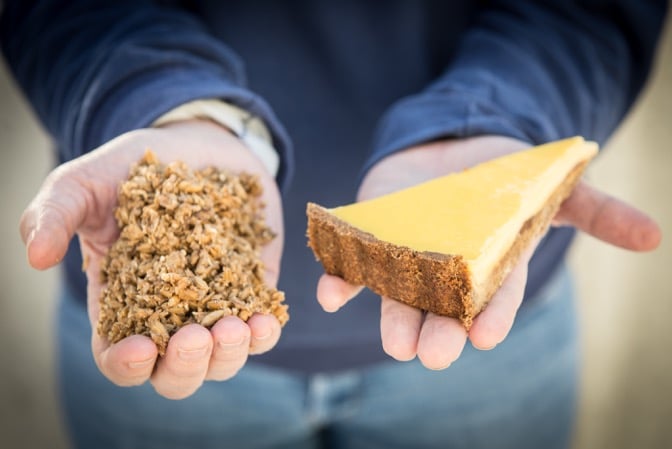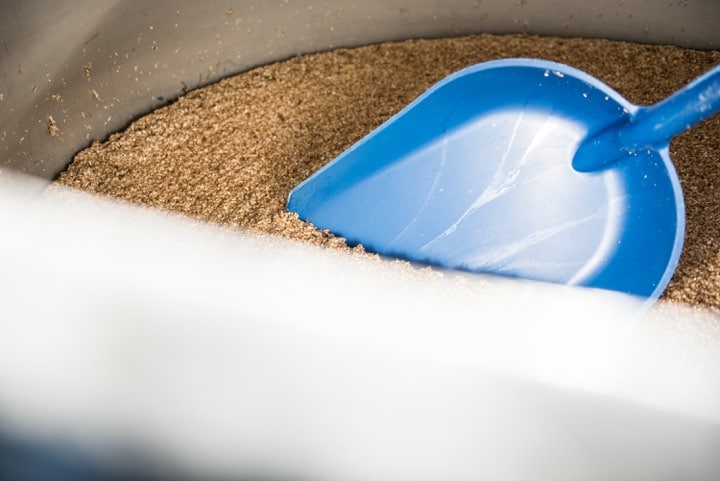
Eco food: Adventures in recycling brewer’s spent grain
The craft beer industry is booming at home and here in the Alps, but more beer production also means an increase in its waste products, namely spent grain and hops. AliKat’s teamed up with Ibex beer in Morzine to help put their spent grain to good use.
What is spent grain?
The process of making beer involves ‘malting’ grains (often barley, but also oats, wheat and rye are common), which means soaking it so it germinates and then gently cooking it. This malted grain is then crushed to open it up and then mashed in the brewer’s Mash Tun (soaked in hot water) to extract the sugars, proteins and nutrients to make the wort for the beer before its boiled. Once this is done, the brewery is left with the ‘spent’ (used) grain.
How can spent grain be put to good use?
For every pint of beer made, the equivalent of two porridge bowls’ worth of spent grain is produced. It can be hard for brewers to find a good home for spent grain, particularly in cities with a lack of farmers, which often feed spent grain to livestock.
Dave from Ibex beer said, ‘Once we’ve got the sugars out of our malted barley, it’s effectively a waste product, but one that can be up-cycled as animal feed, energy bars and all sorts – we send the majority to make bio fuel. Although we have lots of cows here, they are mostly dairy cows and supply milk to make the Abondance AOP cheeses – they are governed by tight rules and can only really eat grass! We were excited to hear Kat’s ideas about ways in which they could re-cycle our used malt in the AliKats’ kitchen’.
Spent grain has up to 80% water content due to the soaking process, so, in its raw form, the grain needs to be re-used very quickly before it goes off. A clever alternative is to dry and stabilise the spent grain – which opens up loads of new, tasty ways to use it. Kat was keen to use the grain to create whole meal flour for baking and tasty granola for breakfast.
But does it really taste good and what’s the nutritional value?
Absolutely, it’s high in protein and fibre, and tastes nutty and sweet. So far, as well as the granola, our guests have enjoyed tarts and muffins all made with spent grain.
What plans do we have for the future use of spent grain in the AliKats kitchen?
The experiment has gone really well and we’d like to continue using the spent grain and try out new recipes. Keep an eye out on our blog as we post more about our recipe adventures in the use of spent grain.
Can I do this at home?
Indeed, you can make flour in these simple steps in most conventional ovens.
- Set your oven at its lowest possible setting, usually somewhere around 170°F. Spread your spent grain out over an oven sheet at a thickness of about half an inch. Put the grain in the oven, but keep the door a little open so that moisture can escape.
- Check the grain every so often; stir it, check how moist it is, and make sure you are not burning it. The idea is to dry it out not cook or burn it.
- Once dried you need to mill it in a food processor, or a coffee grinder also works, to your preferred density.
Now you have flour and are ready to bake!
So why not join us in our spent grain adventures, and speak to your local craft brewer about recycling some of their used malt? Don’t forget to share your adventures with us!
How to eat Reblochon cheese
Mountain cheese, also known as alpage or alpine cheese, is well-known for its unique, complex flavours, and at AliKats we can’t get enough of it! To help you tell your Tomme from your Comté, we’re celebrating a different cheese each month by giving you a bite-sized snapshot to nibble on.…
Continue reading...Easy plum and red onion chutney
As we’re very lucky to have lots of fruit trees on our doorstep, in late September every year I am faced with the delicious problem of what to do with an abundance of fruit. Chutney is always the winning answer! This recipe works for pretty much any type of red…
Continue reading...Skiing with a food allergy in Morzine
For those with food allergies, a skiing holiday might seem like a bit of a minefield when you consider that it usually takes place in an area with a mountain cuisine heavily featuring dairy, meat and wheat, plus a limited choice of eateries, during a time when extreme temperatures and…
Continue reading...Cooking for friends series 04 | Perfect palate cleansers x 3 recipes
Ever carelessly sipped your orange juice after brushing your teeth? It might seem a fussy addition to your dinner party menu, but palate cleansers serve the important purpose of removing any lingering flavours from the mouth. A couple of bites of a light, refreshing flavour, such as citrus, mint or…
Continue reading...
